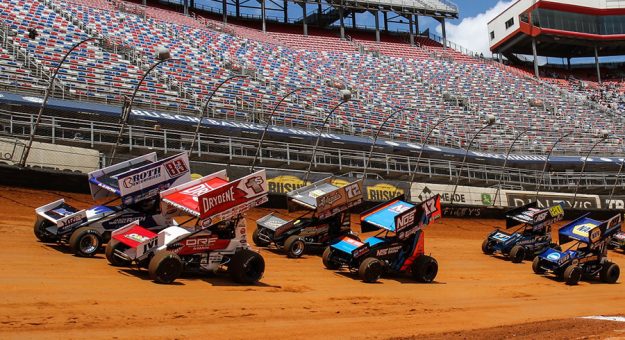CONCORD, N.C. – Fireworks fired into the sky along the backstretch at Bristol (Tenn.) Motor Speedway, in sync with race cars passing by, while banners hung around a colosseum-like facility like art in a house.
Meanwhile, merchandise trailers lined in an orderly fashion by a throng of fans efficiently being shepherded into the track.
Those fans saw the pageantry of four events between the World of Outlaws NOS Energy Drink Sprint Car Series, World of Outlaws Morton Buildings Late Model Series, Super DIRTcar Series and DIRTcar modifieds at Bristol executed to perfection.
What they didn’t see, however, were the months of planning and stress carried on the shoulders of many behind the scenes.
That’s not just for the Bristol events, either. That’s for every event under the World of Outlaws and DIRTcar banners.
The birth of an event starts much further in advance than many may imagine. For Bristol, it started in July of last year, according to World of Outlaws and DIRTcar CEO Brian Carter.
“It was all conceptual,” Carter said about the idea of returning to Bristol. “They didn’t know what the dirt would be or if it would even happen. It was a pretty significant timeline to make it happen. The key, for most of it, was to get where it balances itself into the schedule, because pretty much every weekend is booked with our calendar. So, [something like Bristol] has to fit inside the existing calendar.
“You’re trying to build it in conjunction with the rest of the schedule and the rest of the racing season, because between every weekend from February to November, we’re racing.”
While in the development phase, Carter presented the Bristol idea to Jeff Hachmann, the executive director of events for the World of Outlaws and DIRTcar, who then took it and drew out the blueprints before the foundation is made.
Could the event be profitable? What are the expenses? What is the business relationship with the venue? What works for ticket prices? What are the storylines? How does it fit with sponsors? Will the facility work for the series in general?
Those are just a few of the early questions that need to be answered to bring an event the magnitude of Bristol all together, according to Hachmann.
One of the key early questions in any World of Outlaws event plan to address is whether a race will be promoted by the track, by the series or if it will be a joint venture between the two sides.
That determines who is the lead on the rest of the important questions.
“The historical events are all their own events. The promoters have been in business way before I got involved,” Carter said. “We’ve spent an extraordinary amount of money marketing and building the World of Outlaws brand. Even into the year of COVID last year, we doubled our marketing campaign to raise awareness for the branding. All that advertising and marketing is captured through the fans coming through the gates. We’ve been joint venturing and renting race tracks to really get a return on that.
“All of our new events and events established in the last decade have either been joint ventures or rentals with the race track. Candidly, with 200 big-event-style nights between the Super DIRTcar Series and World of Outlaws, we can kind of mitigate the risk of losing an event to rain. We have a much higher tolerance for having a bad night than a track itself, because we can mitigate it over 20 nights. If you lose one out of 20 in a month, it’s not that bad. We do joint ventures and rentals where we can.”
Bristol is a recent example of a joint venture between the series and the track. The teams from both organizations worked together to make sure every day of the event, and the marketing prior, was flawless. Meetings were held once a week from the beginning of the year up until the day before the event, while departments from both organizations were in constant contact.
In those conversations, there was fine-tuning of the smallest details, like where merchandise trailers needed to be parked, the extent of the use of the media center, making sure there were different color wrist bands for different purposes and who would handle ticketing at the gate.
“We had to divide up all those assets and decide who is doing what, so we didn’t step on each other’s toes,” Hachmann said. “They have a great staff. We have a great staff. How do we use those two staffs to come together?”
To continue reading, advance to the next page.
